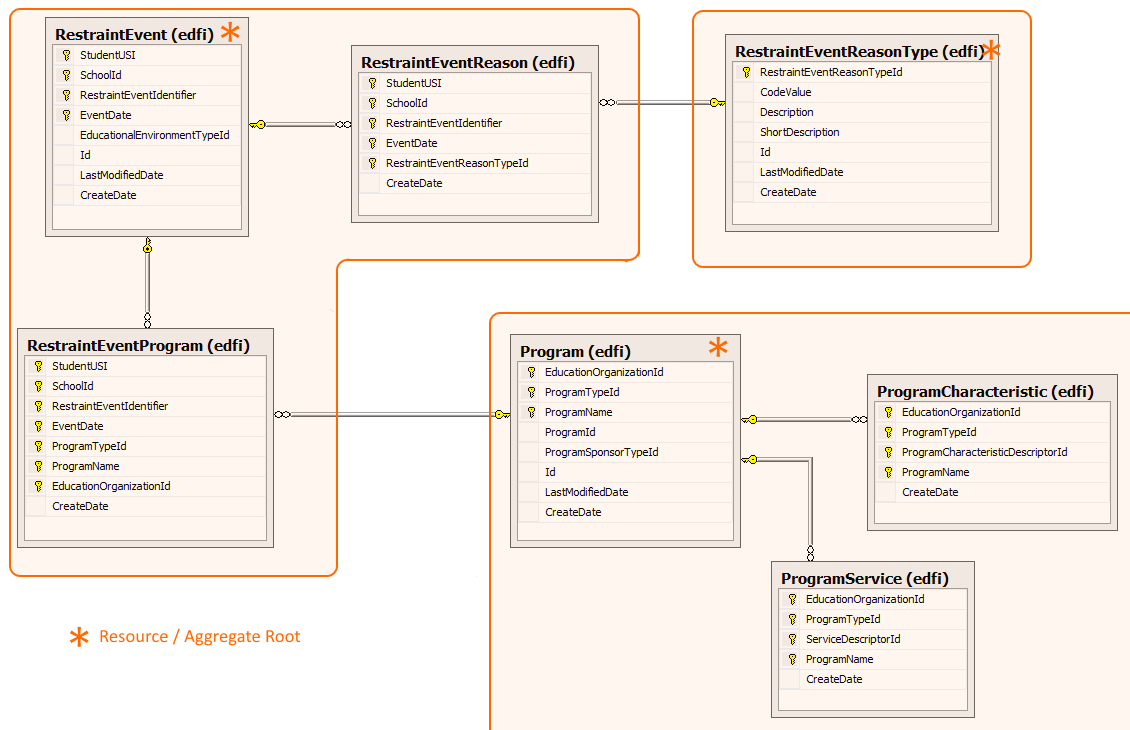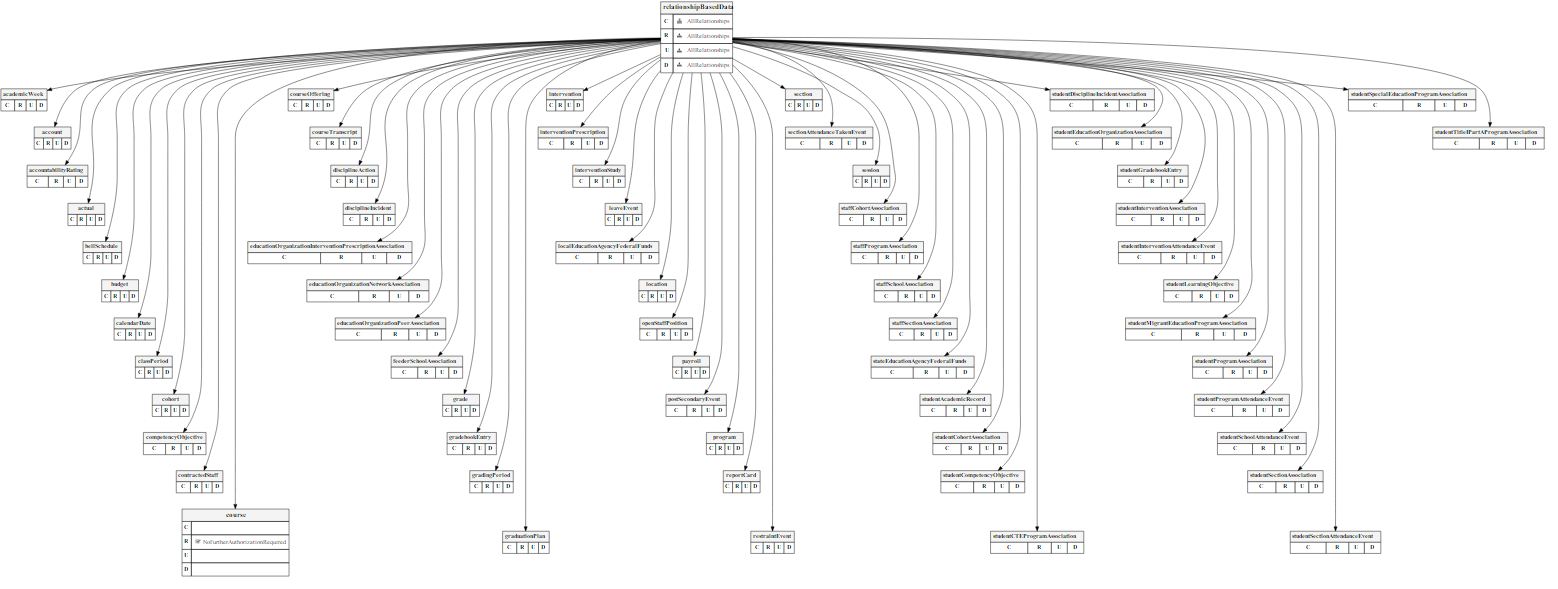A newer version of the Ed-Fi ODS / API is now available. See the Ed-Fi Technology Version Index for a link to the latest version.
API Claim Sets and Resources
Ian Christopher (Deactivated)
Stephen Fuqua
Miguel Kaminski
The Ed-Fi ODS / API provides access to the data stored in an underlying Ed-Fi ODS database only to authorized users and applications. The API is capable of authorizing requests to a granularity of individual API resources while also taking into consideration the caller’s relationship to or ownership of the data in question.
The authorization strategy employs a two-pronged authorization approach. The first component of this approach is relationship-based, whereby vendors are associated with one or more local education agencies for which they can submit and access education data. The second component is resource-based. Using this approach, vendors are given the right to access or perform operations against specific resources. For example, a student information system application can be authorized to access or perform operations against students and staff that are associated with the local education agencies that they serve, while an assessment application can be authorized to view and modify assessment metadata and data that is specifically related to its own assessments.
The key concepts and implementation information follow.
API Resources
The database tables of the Ed-Fi ODS are organized into mutually exclusive groups based on the Domain Driven Design principles for defining aggregates. Each table in the database belongs to a single aggregate, but an aggregate can contain many tables. Each aggregate has an aggregate root, which is the table that represents the top-level element of the exposed object graph. In the Ed-Fi ODS / API, aggregates are exposed as resources.
While there is some good material available on how to determine the most appropriate boundaries for an aggregate in Domain Driven Design, from the perspective of creating Ed-Fi data model representations, there is one main consideration when creating new aggregates or extending an existing aggregate. Each aggregate represents an object graph consisting of a single root object, and may contain subordinate objects (i.e., objects contained in child collections within the object graph). In order for a subordinate object to reference an object external to the graph (generally representing the back-reference of a many-to-one relationship), the target object must be the root of its own aggregate.
The reason for this is obvious if you consider how that outbound link would be represented in JSON:
"schoolReference": {
"schoolId": 255901107,
"link": {
"rel": "School",
"href": "/schools?schoolId=255901107"
}
The outbound href attribute must directly reference a resource available on the ODS / API, which by definition would be an aggregate root.
A further implication of this rule for modeling is that the parent object of a one-to-many relationship must either have its children modeled as a collection within the same aggregate, or it must be an aggregate root itself (so that the back-references from the children can be represented as direct URLs).
The figure below shows a sample of resources related to restraint events.

Claims
Authorization decisions for API requests from a consumer application are claims-based. Each consumer of the API must be issued a key and secret by a system administrator. The key and secret allow the ODS / API system to issue a security token at runtime. The security token must be included with all API requests. Additionally, the consumer application's key will be associated with a specific claim set (i.e., a role). When the consumer calls the Ed-Fi ODS / API, the server will add a collection of claims to the request’s context based on the associated claim set, and the security infrastructure will subsequently use those claims to make authorization decisions.
For example, a Student Information System (SIS) vendor’s token might be given a claim to read the Education Organization data, but a token supplied by an approved System Data Administrator would generally receive claims to read, write, and delete data.
Identity Claims
Identity claims will be issued to enable the authorization layer to identify the caller. For the currently supported scenarios of application-level integration (e.g., for SIS or assessment vendors), an identity claim named “NamespacePrefix” will be issued. This claim is currently used to perform authorization where callers need to manage their own data in the Ed-Fi ODS that is not associated with any specific education organizations, such as custom descriptor values and assessment metadata. The value for this claim will contain a namespace prefix that will be assigned to the consumer when their “Vendor” record is created in the Ed-Fi ODS / API Admin database.
Resource Claims
The claims used for API resource authorization are based directly on the resources exposed by the API, and as such can be referred to as resource claims. Due to the large number of resources, however, they have also been organized into a claims taxonomy. While resource claims can be issued for individual resources, in most cases they will be issued for a higher level conceptual grouping. For example, rather than issue resource claims for each individual type of descriptor, the broader “systemDescriptors” or “managedDescriptors” resource claims will be issued instead.

Resource Claim Values
In .NET, claim values are stored as strings. However, since the API authorization process requires a richer context, the values for the resource claims are actually objects represented as JSON. The claim value will contain the actions that can be performed on the resource, an optional claim set-specific authorization strategy override and some domain-specific context (such as a list of education organization identifiers).
Actions
The Ed-Fi ODS / API supports basic CRUD operations. Thus, the primitive actions that can be added to claims include Create, Read, Update, and Delete. The actions are expressed as URIs, such as https://ed-fi.org/ods/actions/create.
Domain-Specific Context
Another facet of performing some authorization decisions relates to identifying the education organizations that are in context for the claim. For example, a SIS vendor would have permissions to manage student data, but only for students enrolled in schools within the local education agencies they serve. As of this writing, underlying support for any type of education organization is in place, however explicit work has only been undertaken to specifically support local education agencies and schools.
Claims Taxonomy
As described above, the claims taxonomy organizes the granular resource claims into higher-level logical groupings. However, the metadata contained in the taxonomy also identifies authorization strategies for the various claims that are applied after the basic “action” checks have been performed. The figure below shows a representative piece of the Ed-Fi ODS / API claims taxonomy.

The strategy used to authorize a request for an Ed-Fi Type is different from the one used to authorize a request to modify student-related data. The former is a straightforward check against the caller’s claims for requested action on the resource. The latter must also take into account the relationship between the caller and the student.
The authorization strategy may also differ based on the action in the request, such as with the case of creating vs. updating a student (see the “people” resource claim in the figure above). To create a student, a SIS vendor only needs the “student” (or “people”) resource claim with an associated action of “Create”. Once the action on the resource has been verified, there is no further authorization performed. However, to read or update a student, the SIS vendor must not only have been granted the appropriate action, but must also have an established relationship with the student (through the StudentSchoolAssociation resource). As the diagram indicates, this is handled by the “AllRelationships” strategy described below).
Authorization Strategies
The implementation of the Ed-Fi ODS / API includes several authorization strategies, applied to the claims taxonomy shown in the figure above.
- NoFurtherAuthorizationRequired. Explicitly performs no additional authorization (beyond resource/action verification).
- NamespaceBasedFiltering. Allows access to items based on the caller’s NamespacePrefix claim. NamespacePrefix values are assigned when a vendor's record is created in the ODS / API Admin App.
- Relationship-based strategies. A family of strategies that authorize access to student and education organization-related data through ODS relationships from the perspective of the education organization(s) contained in the caller’s claims. The variations provided out-of-the-box are described below.
Relationship-Based Authorization
Many of the Ed-Fi ODS / API resources contain sensitive data subject to FERPA regulations. Access to this data is authorized based on the caller’s relationship to the specifically requested resource. In the Ed-Fi ODS data model, the following tables have been identified as the “primary” relationship tables that define the relationships between people and organizations to be used for authorization purposes:
- StudentSchoolAssociation. Represents a student’s enrollment at a particular school.
- StudentEducationOrganizationResponsibilityAssociation. Used to identify an education organization that is responsible for the student.
- StudentParentAssociation. Associates a parent/guardian with their student(s).
- StaffEducationOrganizationAssignmentAssociation. Captures a staff member’s assignment to an education organization (typically a school or local education agency).
- StaffEducationOrganizationEmploymentAssociation. Captures a staff member’s employment by an education organization (typically a school or local education agency).
Other relationships that have been identified as pertinent, but not primary, to establishing relationships between people and organizations are:
- StaffSchoolAssociation. Captures a relationship with a staff member at the school level.
- StudentCohortAssociation, StaffCohortAssociation. Captures a relationship of a student/staff to an education organization.
The StaffSectionAssociation and StudentSectionAssociation tables capture the classroom level-relationship between staff and students. These are not used in the two-legged OAuth security scheme supported by the shipped code, but would be needed by platform hosts choosing to implement three-legged OAuth or other method for authorizing API requests made on behalf of end-users.
The essence of all relationship-based authorization strategies is to determine whether a path can be established through the primary relationships in the ODS between the education organizations or person associated with the API caller and the education organization and/or person associated with the targeted resource.
The relationship-based strategies available are:
- PrimaryRelationships. Performs a relationship-based authorization where the person identifier associated with the targeted resource is ignored for authorization purposes, and only the education organization identifier is considered. This strategy is generally used for authorizing requests to create the primary relationships, which are then used as the gateways to authorize access to other FERPA-sensitive data.
- AllRelationships. Performs a relationship-based authorization where the identifiers for both people and education organizations are considered. This strategy is the general purpose authorization strategy for establishing relationships to FERPA-sensitive resources from the perspective of the caller’s education organization.
For example, when a SIS vendor sends a request to the API to create a restraint event (see figure above), the resource to be written will be associated with a particular school and student. Since the SIS vendor will have been issued the necessary resource claim with both “Create” and “Update” actions, the “AllRelationships” authorization strategy will evaluate the SIS vendor’s relationship in the ODS to determine if the targeted school is related to the SIS vendor’s education organization(s). If such a relationship exists, then authorization will be granted. If not, an exception will be thrown and the caller will receive a descriptive error message.
Developers' Guide Contents
Find out more about how to develop platforms based on the Ed-Fi ODS / API v5.3: